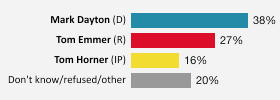Services
MPR News-Humphrey Institute Poll
DFLer Mark Dayton pulls ahead of GOP's Tom Emmer
Minnesota Public RadioSeptember 29, 2010
Democrat Mark Dayton has opened an 11-point lead over Republican Tom Emmer, according to the latest MPR News-Humphrey Institute Poll.
The poll — conducted by Minnesota Public Radio News and the Humphrey Institute at the University of Minnesota — surveryed voters' preferences in the governor's race and approval ratings of politicians. See the full poll report and methodology, or read MPR News reporter Mark Zdechlik's report on this portion of poll.
2010 governor's race
 Among likely voters, Mark Dayton has pulled ahead of Tom Emmer, at 38 percent to 27 percent, respectively. The previous MPR-HHH poll had the two running even at 34 percent support each. Independence Party candidate Tom Horner's support is up to 16 percent from 13 percent
Among likely voters, Mark Dayton has pulled ahead of Tom Emmer, at 38 percent to 27 percent, respectively. The previous MPR-HHH poll had the two running even at 34 percent support each. Independence Party candidate Tom Horner's support is up to 16 percent from 13 percent
It's important to note that fifth of likely voters still say they are undecided.
Key Findings
- • Minnesota voters have awoken from their summer slumber. More than 8 out of 10 Minnesotans are interested in the November elections, a substantial increase that is being propelled by the energizing of formerly turned-off Democrats.
- •Horner is crippling Emmer's campaign, soaking up one-fifth of Republican voters while taking only half as much from Dayton.
- • Dayton is tapping voter frustration and appears better positioned among voters who have not yet declared their support for a candidate.
Party Allegiances Strained, Emmer Coalition Crumbling
The usual party coalitions that unify nearly all Democrats and Republicans behind their Party's standard bearer have broken down in the 2010 gubernatorial contest. In an extraordinary breach, 4 out of 10 Republican voters have not yet declared for Emmer. Dayton is also struggling but not as extensively as his Republican opponent; a third of Democrats are not supporting him at this time.
Move your mouse pointer over the image to compare these results to the August poll.In a dramatic breakthrough, Horner is now drawing 22 percent of Republicans, starting to fulfill his plan to raid the GOP base. He is drawing far less Democrats — 10 percent — while also taking a fifth of independents.
Energized Electorate: Democrats Match Republican Interest
The electorate has changed dramatically in the past month. Since late August, Minnesotans who express a great deal or fair amount of interest in the November elections has jumped from 47 percent to 82 percent.
The outcome of elections often rest on which candidate best turns out their supporters. The story in Minnesota in August was similar to that in many parts of the country — Republicans were more motivated and engaged in the elections. In August, Minnesota Republicans held a significant nine-point advantage (52 percent to 43 percent) in terms of interest in the election. Today, Minnesota Democrats match the interest among Republicans.
About the survey and methodology
This survey is a collaboration between Minnesota Public Radio News and the Center for the Study of Politics and Governance at the University of Minnesota's Humphrey Institute of Public Affairs. The survey was analyzed by the Center. The research team was Lawrence R. Jacobs, the center's director, and Joanne M. Miller, associate professor of political science. Charles Gregory provided research assistance.
The survey was fielded by the Information Specialists Group (ISG) and is based on a landline random digit dial survey in Minnesota. ISG called a sample of telephone exchanges that was randomly selected by a computer from a list of active residential exchanges within Minnesota. Within each exchange, random digits were added to form a complete telephone number, thus permitting access to both listed and unlisted numbers. Within each household, one adult was selected to be the respondent for the survey.
 As is common with public opinion surveys, the data were weighted. In the first stage, the data were weighted based on the number of potential survey respondents and the number of landline telephone numbers in the household. In the second stage, data were weighted according to cell phone usage, as well as gender, age, race, and Hispanic ethnicity to approximate the demographic characteristics of the population according to the Census.
As is common with public opinion surveys, the data were weighted. In the first stage, the data were weighted based on the number of potential survey respondents and the number of landline telephone numbers in the household. In the second stage, data were weighted according to cell phone usage, as well as gender, age, race, and Hispanic ethnicity to approximate the demographic characteristics of the population according to the Census.
Results are based on a model that accounts for the likelihood of a respondent voting based on the following factors: self-reported probability of voting in the upcoming election, voting in the 2006 gubernatorial election as reported by the respondent, interest in the 2010 election, and whether the respondent reported being registered to vote. The model estimates a turnout of 58%, which we expect to increase during the fall as the campaign heats up and interest in the election increases.
Between Sept. 22 and Sept. 26, 2010, 750 likely voters living in Minnesota were interviewed by telephone. The margin of error ranges between +/-3.6 percentage points based on the conventional calculation and +/-5.1 percentage points, which is a more cautious estimate that takes into account design effects, in accordance with professional best practices.
The conventional calculation of the margin of sampling error is primarily based on the number of respondents and, critically, assumes that all respondents selected for interviewing were actually reached. More infomation about the poll's methodology is available in the complete poll PDF.
In The Spotlight
-
The Current Music Blog
Your daily note for good music, news and pop culture. With attempted jokes.


